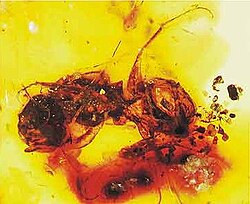| Melittosphex burmensis Temporal range: Upper Cretaceous (Cenomanian?) | |
|---|---|
 | |
| Scientific classification | |
| Domain: | Eukaryota |
| Kingdom: | Animalia |
| Phylum: | Arthropoda |
| Class: | Insecta |
| Order: | Hymenoptera |
| Infraorder: | Aculeata |
| Family: | † Melittosphecidae Poinar & Danforth, 2006 |
| Genus: | † Melittosphex Poinar & Danforth, 2006 |
| Species: | †M. burmensis |
| Binomial name | |
| †Melittosphex burmensis Poinar & Danforth, 2006 | |
Melittosphex burmensis is an aculeate wasp that was formerly considered one of the two oldest-known species of bees. The species was described from an inclusion in Burmese amber in the year 2006 by George Poinar Jr., a zoologist at Oregon State University. The fossil was found in a mine in the Hukawng Valley of northern Myanmar and is believed to date from the Cretaceous Period, 100 million years ago. [1]